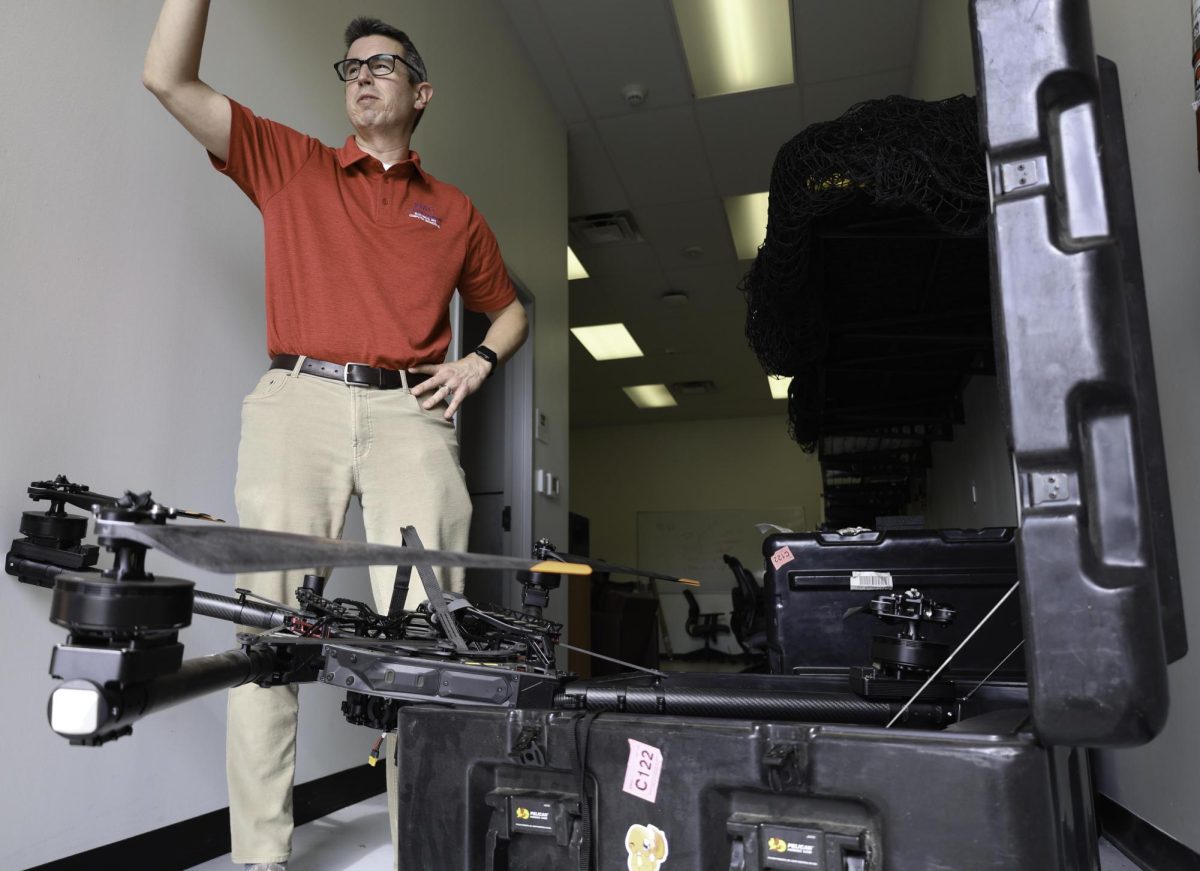Gwen Carris, a civil engineer and Spanish double major, is concerned about water. North Texas is facing one of the worst droughts since the 1950s. Only a sixth of an inch of rain has been reported since last month, for instance. This is why Carris and a group of her fellow students have spent the last year and a half working on The Phytofilter Project: Water Treatment Powered by Plants, a gray water remediation experiment.
Carris ran around collecting bottles and plants in April 2013, which were then used to build the filter. Since then, the experiment has kept her and her colleagues, Jewel Lipps, Nicholas Saulnier and Greg Thompson, busy. The students have also had to keep up with their homework and other activities, but they say it’s been worth it to them because they see water conservation as an urgent issue that needs more attention.
“It’s a deferred maintenance problem that will definitely be a huge problem in the future,” said Carris.
It all started when Carris and Lipps, a chemistry and environmental science double major, went to a convention of The Association for the Advancement of Sustainability in Higher Education (AASHE). There they saw how representatives used plants to treat sewage water so it could be utilized for non-potable purposes.
The students built their filter and tested it for efficacy last year and are now in the final stages of a final report of their data. The project won the award for Innovation Gym Showcase in the 2013 Research Improv Competition in Lyle School of Engineering.
However, the initiative would have not been a reality were it not for the support of Mr. Niraj Bhagat, SMU’s Assistant Director of Environmental Health & Safety and Enterprise Risk Intelligence. He saw the student’s enthusiasm for sustainability and found them the funds for the project.
Even though the filter is only a prototype and there are no plans now to use it on campus, Bhagat was impressed by the student’s cutting-edge technology development. To him, the special aspect of this project was that it was a multidisciplinary one in which the group of four students all came from different fields. From chemistry to various types of engineering, they each brought something special to the project.
In addition to Carris and Lipps, Thompson, a mechanical engineering major, worked on the physical construction of the experiment, while electrical engineering major Saulnier also offered his expertise for the creation of sensors and logging systems for the filter.
“They are tremendous,” said Bhagat. “We are very excited. In fact, these are very exciting times for SMU as many more students are living on campus now.”
Bhagat wants to challenge more students to become engaged with sustainability because SMU is one of the few universities that designates funds for efforts like these. Bhagat believes that students are key to the “greening of minds” and he would like them to embrace other forms of sustainability, even though they might not be instantly gratifying.
Lipps is sure that water can be restored with plants through a recycling process called remediation. During the project’s experimentation process, she was responsible for the natural science component of the Phytofilter experiment. Her science background helped her find the right plant to use for the filtration and also made her responsible for checking the tested water for certain chemicals that can be harmful.
Lipps says the final report will have to wait until the upcoming winter break because even though she has all the data and numbers on her computer ready for review, she and her colleagues are also busy being full-time students and preparing for finals.
“I’m just focusing on the other stuff,” she said.
Thompson also said he had to juggle his part in the group with his school work. He said that while he had little understanding of the chemistry part of the filter, his expertise was in the physics aspect. Thompson designed the prototype of the container the filter was in.
To Thompson, the most novel thing about the phytofilter is that most filters similar to theirs clean water by adding more chemicals to cancel out the harmful ones they are trying to get rid of. Unlike these, the Phytofilter was designed to remove metals and chemicals from the water by using only plants.
“The plants will be able to soak up the problem things like nitrates and heavy metals to leave the water usable,” Thompson said.
Many students at SMU are unaware of initiatives like the phytofilter and the other efforts that SMU works at to conserve water. Very recently, a reporter asked around Hughes-Trigg if anyone knew about SMU’s plant for water reutilization and four out of five people had no clue about the system.
SMU has a plant that recycles storm, ground and boiler water to use in toilets and irrigation of the grounds. The university also collects rainwater on some of the buildings.
Ann Allen is the Senior Grounds Manager at SMU and is responsible for the aesthetics of the school’s 232 acres of landscaped grounds, as well as complying with state irrigation constraints.
“It’s expensive to commit to a program like this,” said Allen.
She is thankful for the many funds SMU designates for sustainability systems despite them being expensive. Allen recognizes water is a finite resource but knows that the school uses available technology while dealing with expectations for the beautiful and safe learning environment the school is recognized for.













